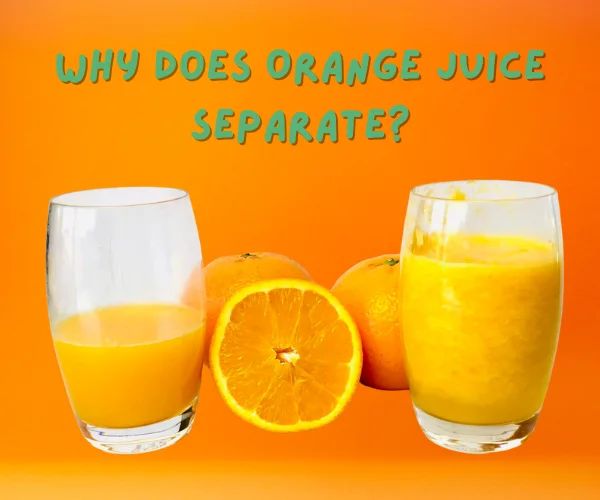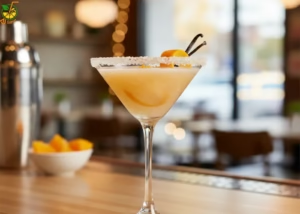Why Does Orange Juice Separate? In beverages, orange juice is a favorite for many, cherished for its refreshing taste, nutritional benefits, and vibrant color.
However, have you ever noticed how your orange juice seems to separate after sitting for a while?
While puzzling to some, this phenomenon is perfectly natural and can be explained through scientific principles.
In this article, we delve into the reasons behind the separation of orange juice, offering insights into the process and tips on enjoying your juice at its best.
Contents
- 1 Understanding the Composition of Orange Juice
- 2 Why Does Orange Juice Separate?
- 3 The Science Behind the Separation
- 4 Is It Normal For Orange Juice To Separate?
- 5 What Keeps Juice From Separating?
- 6 Why Does My Orange Juice Look Milky?
- 7 Why Does Orange Juice Separate In The Fridge?
- 8 How To Stop Juice From Separating?
- 9 Conclusion
Understanding the Composition of Orange Juice
Orange juice is a complex liquid of water, sugars, acids, vitamins, minerals, and many other compounds.
Among these components, two main categories play a pivotal role in the separation process: the water-soluble components and the pulp.
The pulp comprises tiny pieces of orange flesh and cellular material, less dense than the liquid part of the juice.
Why Does Orange Juice Separate?
You mix water, sugar, vitamins, and other compounds when you squeeze oranges to make juice. However, not all of these parts mix perfectly.
Here’s what happens: the pulp and heavier components settle at the bottom after a while. This is because they’re denser than the liquid part of the juice.
Think of it like when you mix oil and water; they don’t stay mixed because their densities differ.
Also, orange juice contains natural enzymes that can break down the juice over time, causing further separation.

That’s why when you leave a carton of orange juice in the fridge for too long without shaking it, you’ll notice the heavier parts sink to the bottom and need to shake it up again before drinking.
So, in short, orange juice separates because of differences in density between its components and the natural process of the juice breaking down.
A good shake before pouring is all it needs to return to its delicious, mixed state!
To enjoy orange juice at its best, consider the following tips:
1. Shake Well Before Serving: This simple action can redistribute the pulp throughout the juice, ensuring a consistent flavor and texture.
2. Store Properly: Refrigerating orange juice can slow separation and preserve its freshness.
3. Consume Promptly: Fresh orange juice is best enjoyed soon after opening, as exposure to air can lead to oxidation and nutrient loss.
The Science Behind the Separation
The separation of orange juice is primarily due to a phenomenon known as phase separation.
This occurs when the different components of a mixture have varying densities and do not remain evenly distributed within the mixture.
In the case of orange juice, the pulp tends to rise to the top due to its lighter density compared to the water-rich liquid, which settles at the bottom.
This process is further influenced by the principle of sedimentation, where the heavier particles settle under the force of gravity.
Is It Normal For Orange Juice To Separate?
Yes, it’s perfectly normal for orange juice to separate. This phenomenon occurs due to the natural composition of orange juice, which includes water, sugars, vitamins, minerals, and pulp.
The pulp, made up of tiny pieces of orange flesh, tends to rise to the top of the juice container because it’s less dense than the liquid portion.
This separation is a natural process called phase separation, where components with different densities within a mixture distribute unevenly under the influence of gravity.
No artificial or harmful processes cause this separation; the physical properties of the components in orange juice act naturally.
You can shake the orange juice container before pouring it to enjoy a more uniform consistency.
This action redistributes the pulp throughout the juice, ensuring a consistent flavor and texture with each glass.
What Keeps Juice From Separating?
Emulsifiers and stabilizers keep the juice from separating. When I look into my favorite juices, I often find ingredients like pectin or gum arabic listed.
These are natural substances added to juice to mix the water and pulp well. They work by increasing the viscosity of the juice.
This means they make the juice thicker, so the pulp doesn’t separate and float to the top as quickly.
Think of emulsifiers as the peacekeepers of the juice world, holding all the different parts together in harmony.
So, when I shake my juice bottle, which stays mixed for longer, I have these handy ingredients to thank.
Why Does My Orange Juice Look Milky?
Your orange juice looks milky because of the tiny particles of pulp and natural oils from the orange.
These particles get finely dispersed throughout the liquid when I squeeze oranges or shake the juice.
This dispersion scatters light in all directions, giving the juice a cloudy or milky appearance.
It’s natural, especially in freshly squeezed or pulpy orange juice.
So, when I see my orange juice looking a bit cloudy, I know it’s just full of natural goodness.
Why Does Orange Juice Separate In The Fridge?
Orange juice separates in the fridge because of the different densities of its components.
In my experience, the pulp, made up of tiny pieces of orange flesh, is lighter and tends to float to the top. Meanwhile, the heavier liquid part settles at the bottom.
This process, called sedimentation, happens more slowly in the fridge because the cold temperature thickens the juice slightly, reducing the movement of the particles.
So, when I store my juice in the fridge and notice the separation, it’s just the natural behavior of the juice’s components reacting to gravity and temperature.
A quick shake before serving usually mixes everything back together nicely.
How To Stop Juice From Separating?
Stopping juice from separating might be tricky since it’s a natural process, but I can share a few tips to slow down the separation and keep your juice looking fresh and delicious for longer.
Here’s what you can do:
1. Shake Well Before Serving: This is the simplest way to mix everything back together. Giving your juice bottle a good shake before you pour it will redistribute the pulp and liquid evenly.
2. Store it Properly: Keeping your juice in a tightly sealed container in the refrigerator can slow the separation process. Cold temperatures slow down the movement of the molecules, which, in turn, slows down separation.
3. Use a Blender: If you’re making fresh juice, blending it for a little longer can help break down the pulp more finely, making it less likely to separate quickly. This creates a smoother juice.
4. Add a Natural Emulsifier: Ingredients like lecithin (found in soy and sunflower seeds) can act as natural emulsifiers. Adding a small amount to your juice can help keep it mixed together. However, this is more common in homemade juice recipes.
5. Consume Quickly: Fresh juice is best enjoyed soon after it’s made. The longer it sits, the more it will separate. So, try only to make as much juice as you’ll drink at one time.
Remember, separation is a natural sign that your juice doesn’t have added stabilizers or artificial ingredients, which is good! A quick shake is all it takes to get it ready to drink.
Conclusion
The separation of orange juice is a natural occurrence resulting from the different densities of its components.
Understanding the science behind this phenomenon can enhance our appreciation of this beloved beverage and help us enjoy it in its optimal state.
We can ensure that our orange juice remains delicious and refreshing by employing simple storage and preparation tips.

Welcome to alljuicecorner.com, your go-to resource for all things juice! I’m Marina, the passionate juice enthusiast and health advocate behind this vibrant community. My journey into the world of juicing began five years ago, sparked by a desire to embrace a healthier lifestyle and explore the nutritional power of fruits and vegetables. I spent countless hours researching, experimenting with different combinations, and understanding the science behind each sip.
I bring a wealth of knowledge and practical experience to the juice table. My mission is simple: to share the joy and health benefits of juicing with as many people as possible. Through “alljuicecorner.com,” I aim to demystify the world of juicing, offering easy-to-follow recipes, tips on selecting the right produce, and insights into the health benefits of various ingredients. Whether you’re a seasoned juicer or just starting, this blog is designed to be your companion on this delicious journey.



